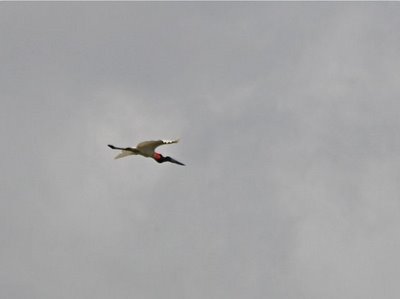
Jabiru! Just the name sends a thrill through any aspiring Neotropical birdwatcher. Though they occasionally show up in Texas as vagrants, you really have to be in the tropics to see this magnificent stork.
The jabiru eats fish, crustaceans, mammals, reptiles, amphibians: whatever it can subdue with its enormous, slightly uptilted bill. That's probably most of the animals it encounters, because this thing is BIG. It is the tallest bird in the Americas, standing nearly five feet, tipping the scales at almost 17 pounds, looking me right in the eye. And I can tell you I would not want a jabiru to look me in the eye at close range. Herons and storks have a disconcerting way of aiming for the eyes of people who tick them off. So I will have no hair-raising tales of patting the jabiru.
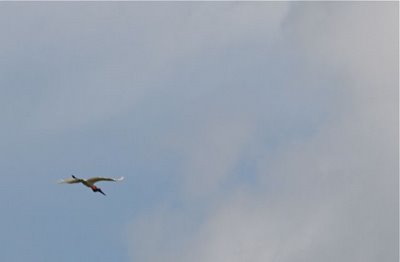
I'd only ever had distant and pretty crummy looks at jabirus in Costa Rica.
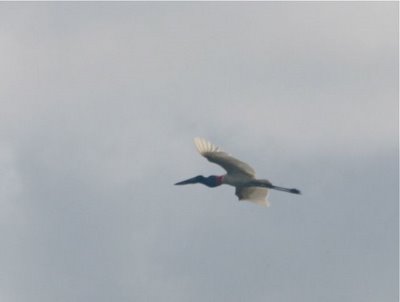 To come to a place where they were reasonably common and easy to see was a great thrill. Guyana thrilled me in so many ways.
To come to a place where they were reasonably common and easy to see was a great thrill. Guyana thrilled me in so many ways.Flying jabirus are distinctive mainly by their absolute hugeosity. Not only that, but their plumage is completely white--no black primaries here. Their feathers must be enormously strong, both to hold their weight and to resist wear without the aid of melanin, the dark pigment that strengthens the wingtips of most white-winged birds.
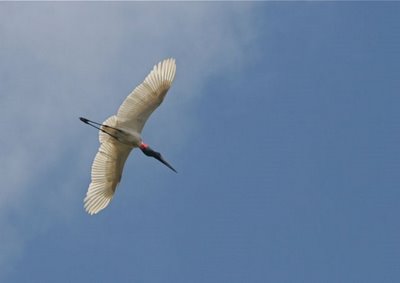
In flight, jabirus appear very neck-heavy. Its name is a Tupi Indian word meaning "swollen neck." Yeah.
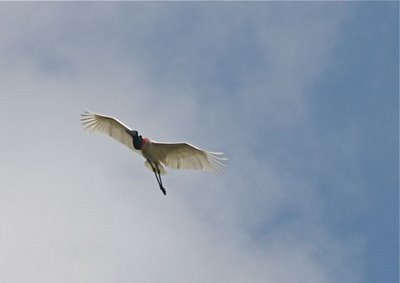 Most of the birds that we saw were circling in pairs or even quads, and we witnessed a few really strange neck-throwing displays in flight, where the bird would toss its head over its back, flashing a big red patch at the base. I wish I had a picture of the bird with the head thrown up, but it happened really fast.
Most of the birds that we saw were circling in pairs or even quads, and we witnessed a few really strange neck-throwing displays in flight, where the bird would toss its head over its back, flashing a big red patch at the base. I wish I had a picture of the bird with the head thrown up, but it happened really fast.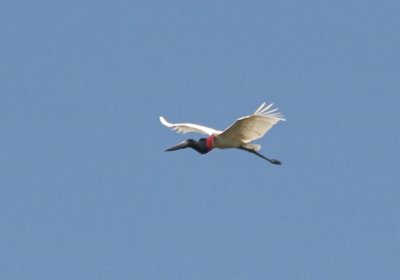 The display looked aggressive in nature to me, but one never knows. It could just as easily have been a breeding display. I noticed that the base of the neck varied in color; most birds that have such skin coloring are able to deepen the hue by allowing blood to rush to the part. Think turkey heads, which can go from blue to blood-red to snow-white in a few seconds. Whether this is something that is under voluntary control I don't know; it's more likely related to how excited the bird happens to be.
The display looked aggressive in nature to me, but one never knows. It could just as easily have been a breeding display. I noticed that the base of the neck varied in color; most birds that have such skin coloring are able to deepen the hue by allowing blood to rush to the part. Think turkey heads, which can go from blue to blood-red to snow-white in a few seconds. Whether this is something that is under voluntary control I don't know; it's more likely related to how excited the bird happens to be.Oh, gosh I love jabirus, and I had a hard time picking my favorite photos. When I am focused on a circling jabiru, I'm very happy that my camera, set on Auto, knows what to do to bring out the detail against a bright sky. Tomorrow, a jabiru nest!
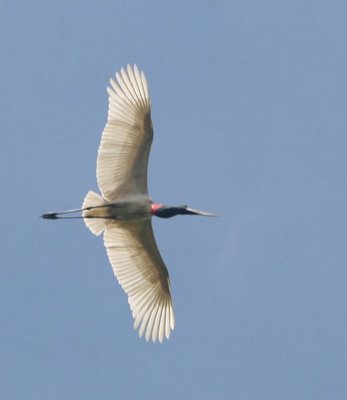






11 comments:
Love the bird. I can't believe its size and weight, and I can appreciate the strength in those wings.
This trip is great, Julie.
Great bird, great name, great post.
Jabiru! Gorgeous- they remind of the marabou in africa. Great photos- magnificent wings!
Such a large...but graceful looking bird.
I'm sooooo very glad there wasn't a hair-raising petting-the-jabiru story. Thanks for that interesting bit about melanin both coloring and strengthening bird feathers. Wow!
"So I will have no hair-raising tales of patting the jabiru."
I guess that means you didn't let any suck on your fingers like the manatee?
:)
Wow! so many birds...so little time!
I'm glad to know that storks and herons would peck out my eyes up close.
Spending so much time around them has made me somewhat complacent but they don't let me get very close...
Since I'm such a local artemis, I appreciate the international birding education! Keep traveling, Harvard!
Gulp... a five foot tall bird? Uh, I am only 5'2". I think I'll just enjoy the flight photos. :c)
A bird as tall as my librarian! Really liked the thoughtful school post as well.
Great post, Jules!
neat photos. Maybe we wll all have to go to Guyana
My word verification
sedge - a real word, they must have messed up.
Post a Comment